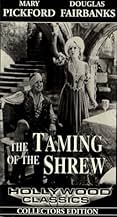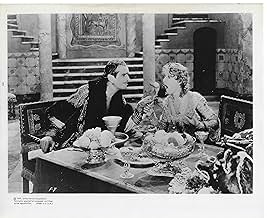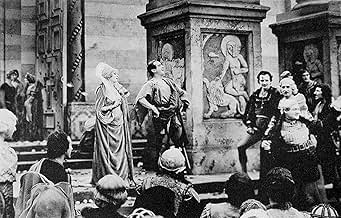Aggiungi una trama nella tua linguaIn sixteenth century Padua, Hortensio loves Bianca, the youngest daughter of Baptista. But Baptista will not allow the two to get married until his eldest daughter, the extremely headstrong ... Leggi tuttoIn sixteenth century Padua, Hortensio loves Bianca, the youngest daughter of Baptista. But Baptista will not allow the two to get married until his eldest daughter, the extremely headstrong Katherine, is betrothed. This task seems impossible because of Katherine's shrewish demean... Leggi tuttoIn sixteenth century Padua, Hortensio loves Bianca, the youngest daughter of Baptista. But Baptista will not allow the two to get married until his eldest daughter, the extremely headstrong Katherine, is betrothed. This task seems impossible because of Katherine's shrewish demeanor. They believe their prayers have been answered with the arrival from Verona of the lust... Leggi tutto
- Regia
- Sceneggiatura
- Star
- Premi
- 2 vittorie totali
- Servant
- (non citato nei titoli originali)
- Little Boy
- (non citato nei titoli originali)
- Little Girl
- (non citato nei titoli originali)
- Servant
- (non citato nei titoli originali)
Recensioni in evidenza
Of the two stars, Doug is clearly the better. Director Sam Taylor moulds the roles around the performer, and not the other way around, which was unwise but understandable. The Fairbanks image suits Petruchio better than Pickford's suits Kate. (At her best Pickford is magnificent, at her worst embarrassing. She herself called it one of her worst performances, and there is no reason to doubt her.)
For an early talkie it has remarkable fluidity, though it is only the 1966 re-edited version that is available today. (When I approached the Mary Pickford Company in 1992 to see if I could arrange a screening of the 1929 release print - which was longer and had a different score - I was politely but firmly told to go away!)
Two points of interest. This film was emphatically not the box office flop that many writers have claimed; it returned a healthy profit on its first release. And the credit line "by William Shakespeare, with additional dialogue by Sam Taylor" is pure myth. It appears not in the script, the 1966 nor in the 1929 (I have it on reliable authority) prints of the film. Where do these things get started?
Hollywood royalty Douglas Fairbanks and Mary Pickford star as Kate and Petruchio, the warring couple who really love each other on the sly. Their marriage was a sham by the time this flick came out, and both their careers were on the wane, but they give reasonable enough performances, even though Fairbanks looks a few years too old for his part when the camera gets close. There's still a tendency to exaggerate their gestures and overact to responses to words being spoken, but they're no worse than any other stars making their first sound films.
It's clear that Hollywood back then had no more confidence in the intelligence of its audience than it does today: this is Shakespeare for the common man, with the pith of the Bard's prose removed in order to make the words readily understandable to all. Although the film is little more than an hour long, it does begin to drag during the last twenty minutes but, that aside, it's not a bad effort.
The movie was a vehicle for real-life husband and wife Douglas Fairbanks and Mary Pickford, he in his first talkie, she in her second. Given the state that their marriage had degenerated into by this point, the storminess between the two of them probably wasn't that far from the truth. They both act well it has to be said, hamming it up magnificently in a manner drawing upon their experience both in stage and silent cinema, and which you can only really get away with in the context of this play's comical theatricality.
The director is Sam Taylor, a man with a background in comedy, who helmed the finest Harold Lloyd movies during the silent era. The Taming of the Shrew sees him returning to his roots, staging the verbal comedy as broad slapstick. Taylor is a master of the pull-back-and-reveal gag, making us think one thing then punch-lining us with another. In adapting the play, he pares down Shakespeare's dialogue, and reduces it for the most part to a poetic backdrop, allowing the comic vignettes to tell the story. This is quite something, because this style of physical comedy more or less died out when the talkies came along, but here Sam Taylor is showing a way it could have continued.
But what is also intriguingly good about this version of The Taming of the Shrew is its sly subversion of Shakespeare's misogyny. The bard's lines remain what they are, but the action in between them is enough to tweak their message. Pickford is brilliantly sarcastic for Katherine's final speech, and as Fairbanks sits beside her with a large bandage on his head, it becomes clear who's taming whom.
Lo sapevi?
- QuizIn her later years, Mary Pickford stated that working on the film was the worst experience of her life, although she also acknowledged that Douglas Fairbanks's performance was one of his best.
- Versioni alternativeAfter many years out of circulation, the film was re-released in 1966 in a new cut supervised by Mary Pickford herself. New sound effects were added throughout, much of the voice dubbing was enhanced with newly available technology, and seven minutes were cut from the initial print. This re-released version is the only version now available on DVD or VHS.
- ConnessioniFeatured in Mary Pickford: A Life on Film (1997)
I più visti
Dettagli
- Data di uscita
- Paese di origine
- Lingua
- Celebre anche come
- The Taming of the Shrew
- Luoghi delle riprese
- Aziende produttrici
- Vedi altri crediti dell’azienda su IMDbPro
Botteghino
- Budget
- 504.000 USD (previsto)
- Tempo di esecuzione
- 1h 3min(63 min)
- Colore

















